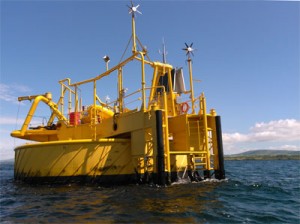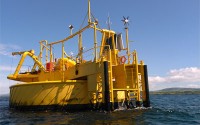How Single Buoy Moorings Work
Also referred to as single-point mooring (SPM), the single buoy mooring or SBM is an offshore anchored loading buoy, serving as a mooring point as well as interconnect for ocean going tankers offloading and loading liquid or gas products. SPM/SBMs become the connection between weathervaning tankers and the geostatic subsea. They have the capacity of handling any ship size including Very Large Crude Carriers whenever an alternative facility is not available.
Single point mooring buoy is made up of a permanently moored buoy that is connected to the seabed via several mooring lines. It contains a bearing system allowing a section of it to easily rotate around the geostatic part that is moored. This makes it possible for the moored vessel to weathervane freely around the buoy?s geostatic part.
Single Buoy Moorings Video demo
Product Transfer System
Usually, the buoy body is supported on seabed attached static legs, with the rotating section located above the water level which is then connected to the tanker that is loading/offloading. These two portions get connected using a roller bearing. With this arrangement, the sea vessel that is moored can weather vane freely around the linked buoy and get a position that is stable.
At the heart of each buoy lies the system for product transfer. Starting from a geostatic location such as Pipeline End Manifold or PLEM that is seabed located, this is the system that transfers products to the tanker.
As the seabed moored vessel finds a balance and rotates itself into the prevailing environment, the product transfer system minimises the loads being placed on the buoy?s mooring system. This SPM system capability is also employed during the vessel approach as it comes in to moor, maximising control at the same time minimising the tug assistance need.
The system of mooring could in addition get combined with a system of fluid transfer enabling subsea pipelines connection to the tanker.
Mooring and Anchoring Parts
Moorings are what fix the buoy onto the seabed. The design of the buoy must account for the buoy behaviour given applicable tanker sizes, wave and wind current conditions. This is what establishes the mooring leg components size and the optimum mooring arrangement. The anchoring points greatly depend on the condition of the local soil.
The product transfer system basic components are:
1. The Risers
These are flexible hoses connecting the buoy to the subsea piping. The risers configuration could vary based on buoy motions, sea state, water depth, etc.
2. Floating Hose String
These link the offloading/loading tanker to the buoy. The hose string or strings may come along with a breakaway coupling that prevents hoses/hawser rupture and potential oil spills.
3. Product Swivel
This is the link between the buoy?s rotating part and the geostatic. It facilitates the rotation of an offloading tanker with respect to the buoy. The size of the product swivels can vary based on the attached piping and risers size. The product swivels can supply one or multiple independent paths that can carry gases, fluids, power or electrical signals. Swivels come equipped with several seal arrangement geared towards minimising the potential of product leakage into the environment.
Other SPM/SBMs possible components include:
- A boat landing that provides buoy deck access
- Fendering for buoy protection
- Equipment for lifting and handling to assist in materials handling
- Maritime visibility navigational aids, and fog horn that keeps moving sea vessels alert
- Electrical subsystem that facilitates valve operation and powers the navigation aids or any other types of equipment
Conclusion
Several of the single point mooring SPMs are typically products which you can get off-the-shelf with several standard options. However, some come custom-designed. In this case the mooring system and its components are always designed specifically to match the requirements of the vessel and the conditions of the local environment.

